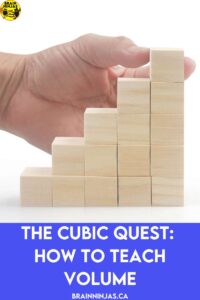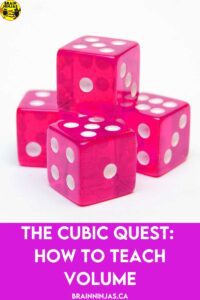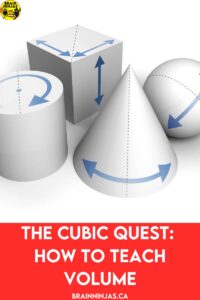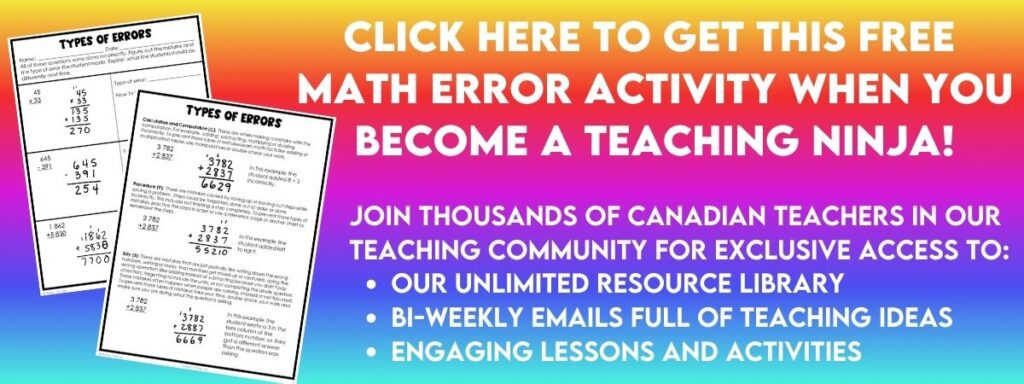
Some students struggle with the concept of volume, but we’ve been doing this long enough that we can help. Generally, students mix up volume with capacity or don’t completely understand how to calculate the volume of different shapes. Come learn some of our tried and true activities that we use to help students understand volume.
Start With a Hands-On Activity
Without telling students exactly what you’ll be doing, hand out Unifix cubes, snap cubes, ones cubes from your Base 10 set, or any other cubes that your students can explore with. The cubes need to be the same size, but if you don’t have enough for all your students, put students in small groups and give them a handful of the same size of cubes.

Ask students to build something, but don’t give them any other instructions. Once they are finished, they can put the rest of the cubes to the side. Ask students to count all the cubes used in their sculpture. Explain to students that this result is the volume of the sculpture. Their measurement would be (the number) in units cubed. We write that as the number, the units (or the objects) and a small three, written offset to the units (m³). We say it as cubic units. For example, 5 m³ is said as five cubic metres (although saying five metres cubed is not wrong).
Formally Introduce Volume
Explain to students that volume is the amount of space occupied by a three-dimensional object, such as a cube, rectangular prism, or cylinder. If your students have already learned about capacity, this might be confusing for them. Remind students that capacity is the amount an object can hold. Volume is the amount of the object.
Introduce students to common metric units of volume measurement, such as cubic centimetres (cm³) and cubic metres (m³). Emphasize the importance of using consistent units when measuring and calculating. If students are wondering about using cubes, explain that all the cubes are the same size (that is the consistent part).
Explain that volume measures all 3D objects, but if that object is a liquid, it can be measured in liquid measurements like millilitres or litres. If it’s solid, it’s more likely to be measured in centimetres or metres.
Use Hands-On Teaching Strategies
Build More Things With Cubes

Use more cubes to build more shapes. Have students count the number of cubes used to build each shape and calculate the total volume by multiplying the length, width, and height. Have students estimate the number of cubes for a sculpture built by a friend and then count them to verify it.
Water Displacement Experiment
Conduct a water displacement experiment where students submerge irregularly shaped objects in water and measure the water that is displaced. Encourage students to record their observations and calculate the volume of each object.
Volume Challenges
Present students with a series of volume challenges involving real-world scenarios, such as packing boxes for shipping or filling containers with small objects. Encourage students to apply their knowledge of volume measurement to solve practical problems.
Measure Real-Life Prisms
If you can find boxes for snacks (like Smarties, cereal, or cookies), students can measure the volume of these objects and then have a treat. They’ll be able to calculate the volume of that box of Smarties without any trouble if they think they’ll get to eat them when they’re done.
Teach the Formula for Rectangular Prisms (or Cubes)
The formula for volume is length x width x height = volume (lwh=v). When you teach students the volume, be sure to show them where the length, width, and height are on the prism they are measuring. Explain that the order the numbers are multiplied does not matter. You can even test it out with students to compare the results. Some students get stuck on this.
Make an anchor chart with a drawing of a prism and the formula when students are first starting to use the formula. It will help reinforce the formula as students learn to make the measurement calculation.
Use Worksheets and Task Cards to Practice

We have created some worksheets to help students reinforce their learning. If you are looking for some interesting ways to use your worksheets, check out this post: Math Worksheet Games Your Students Will Love.
Volume of Rectangular Prisms Worksheets with Metric Measurements. Students will get to work through a variety of questions. They can use formulas to calculate the volume. Find it in our TpT Store ($USD) or our BN Shop ($CAN).
Volume of Rectangular Prisms Task Cards with Metric Measurements Our task cards include a paper version, a Google Slides version, and a self-marking Google Forms version. We have included three different decks, so you can differentiate for your students. The third deck in this set has volume puzzles where students have to figure out the missing side length after being given all the other measurements. Find it in our TpT Store ($USD) or our BN Shop ($CAN).
Comparing Volume and Area Worksheets with Metric Measurements. Students will get to work through a variety of questions that require them to calculate volume, perimeter, or area. They can use formulas to calculate the volume. Find it in our TpT Store ($USD) or our BN Shop ($CAN).
Use Error Analysis
One way we encourage students to check their work is by using error analysis. We have a complete lesson in our post, How to Teach Students to Analyze Errors in Math. We also have this free lesson that we can send directly to your inbox when you sign up for our email list. If you’re already on the list, you can find this lesson in our Resource Library.
The lesson is modelled using operations, but you can easily change out the worksheets or questions to make volume calculations.
Video Resources

Math With Mr. J has a video that uses the formula (he also uses a formula that uses v-bh, so be sure to preview it before showing it to your students).
Khan Academy’s “Volume of Rectangular Prisms” includes working through the formula but has some measurements other than metric.
Do You Teach Math in Canada?
Your students will do so well with you guiding them, but it can be challenging to find resources that are meant specifically for Canadian students. That’s our mission and maybe these blog posts can help you.
Amazing Measurement Activities to Stretch Math
How to Change Math With Interactive Notebooks
How do you teach volume to your students? We’d love to hear about it. Leave us a comment below.







